Work in pairs. Look at the pictures. Ask and answer.
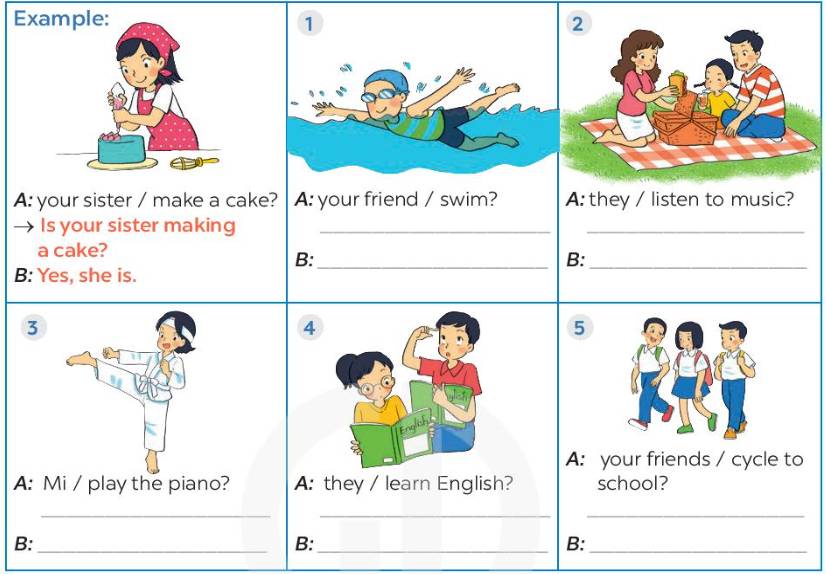
Work in pairs. Look at the pictures and answer the following questions.
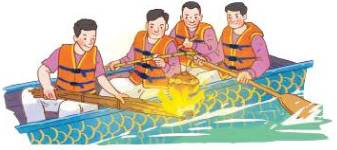
1. What are the men doing?
2. When do you think this event occur?
1. Farmers compete cooking rice on boat.
2. I think it’s occur in the Lunar New Years.
Work in pairs. Look at the pictures and discuss the environmental problems you see.
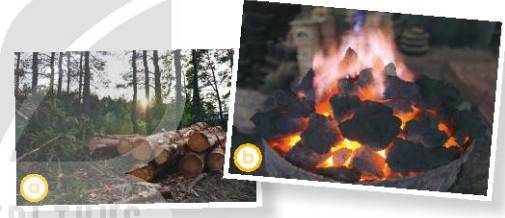
Picture A: Deforestation is a significant environmental issue that occurs when forests are cut down for various reasons. This can result in a loss of plant and animal species, soil erosion, and climate change. Deforestation can negatively impact human communities that rely on forests for their livelihoods. It is important to take action to prevent deforestation and protect our forests for future generations.
Picture B: CO2 emissions are a significant environmental problem that occurs when large amounts of carbon dioxide are released into the atmosphere from human activities. This contributes to the greenhouse effect and global warming, which can have serious consequences such as rising sea levels and more extreme weather events.
Picture A: deforestation
Picture B: air pollution
Work in pairs. Ask and answer about Vu Quang National Park. Look at the facts.

Example:
A: Where is Vu Quang National Park?
B: It's in Vu Quang District, Ha Tinh Province.
Tham khảo
A: Where is Vu Quang National Park?
B: It's in Vu Quang District, Ha Tinh Province.
A: When did Vu Quang National Park open?
B: It's opened in 2002.
A: What is the area of Vu Quang National Park?
B: About 55,000 hectares.
A: What kind of species does Vu Quang National Park has?
B: It has Saolas, "black deer" and also valuable plants, woods, medicinal plants.
Can you add some more activities?
Work in pairs. Ask and answer about the pictures in 4.
Example:
A: What are they doing in picture a?
B: They're ploughing a field.
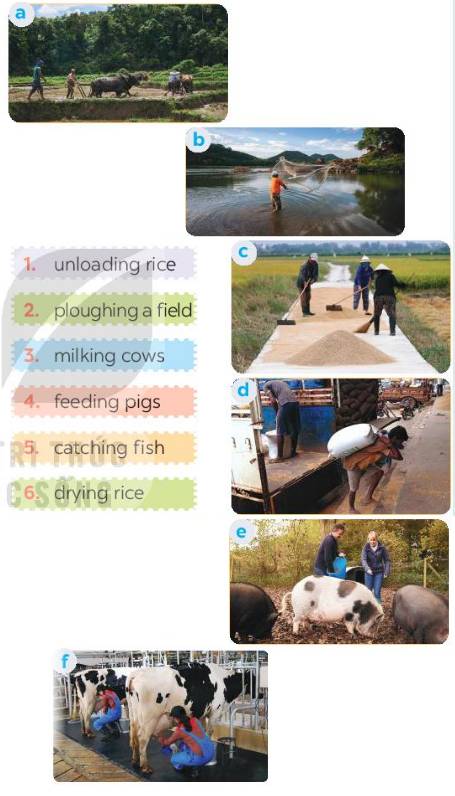
- What are they doing in picture b? They're catching fish.
(Họ đang làm gì trong bức ảnh b? Họ đang bắt cá.)
- What are they doing in picture c? They're drying rice.
(Họ đang làm gì trong bức ảnh c? Họ đang phơi lúa.)
- What are they doing in picture d? They're unloading rice.
(Họ đang làm gì trong bức ảnh d? Họ đang dỡ lúa.)
- What are they doing in picture e? They're feeding pigs.
(Họ đang làm gì trong bức ảnh e? Họ đang cho heo ăn.)
- What are they doing in picture f? They're milking cows.
(Họ đang làm gì trong bức ảnh f? Họ đang vắt sữa bò.)
Look at the pictures. Ask and answer.


- Is the monkey eating in Picture C? (Có phải con khỉ trong tranh C đang ăn không?)
No, it isn’t. (Không phải.)
- What’s it doing? (Nó đang làm gì vậy?)
It’s climbing. (Nó đang trèo.)
- Is the tiger sleeping in picture A? (Có phải con hổ ở tranh A đang ngủ không?)
Yes, it is. (Đúng vậy.)
SPEAKING Work in pairs. Look at the photo. Ask and answer the questions.

1. Which tour attraction is it?
2. Have you been there? lf so, did you have a good time?
3. If you haven't been there, would you like to go? Why? Why not?
A: Which tour attraction is it?
B: I don't know but I guess it is a famous tourist attraction in the world because I can see many visitors in the picture.
A: Have you been there?
B: Actually, I haven't been there before. That's the reason why I don't know where it is.
A: If you haven't been there, would you like to go?
B: I'm a big fan of traveling, so I would like to go to this place to visit.
A: Why?
B: You know, I like exploring and experiencing a lot of famous tourist attractions. Moreover, if we stand on the bridge in the picture, we can see the beautiful weather and many spectacular views. I’m sure that I will really enjoy that feeling.
Tạm dịch:
A: Đó là điểm tham quan du lịch nào?
B: Tôi không biết nhưng tôi đoán đó là một điểm thu hút khách du lịch nổi tiếng trên thế giới bởi vì tôi có thể thấy nhiều du khách trong bức ảnh.
A: Bạn đã ở đó chưa?
B: Thực ra, tôi chưa từng đến đó trước đây. Đó là lý do tại sao tôi không biết nó ở đâu.
A: Nếu bạn chưa đến đó, bạn có muốn đi không?
B: Tôi là một người rất thích đi du lịch, vì vậy tôi muốn đến nơi này để tham quan.
A: Tại sao?
B: Bạn biết đấy, tôi thích khám phá và trải nghiệm rất nhiều điểm du lịch nổi tiếng. Hơn nữa, nếu chúng ta đứng trên cây cầu trong hình, chúng ta có thể nhìn thấy thời tiết đẹp và nhiều cảnh đẹp ngoạn mục. Tôi chắc chắn rằng tôi sẽ thực sự tận hưởng cảm giác đó.
Exercise 2. ROCK, PAPER, SCISSORS. Work in pairs. Look at pictures 1-4 and play the game. The loser says two sentences about picture 4, one in the present continuous affirmative and one in the present continuous negative.
(KÉO BÚA BAO. Làm việc theo cặp. Nhìn vào hình 1-4 và chơi trò chơi. Người thua nói hai câu về hình ảnh 4, một câu ở hiện tại tiếp diễn khẳng định và một câu ở hiện tại tiếp diễn phủ định.)

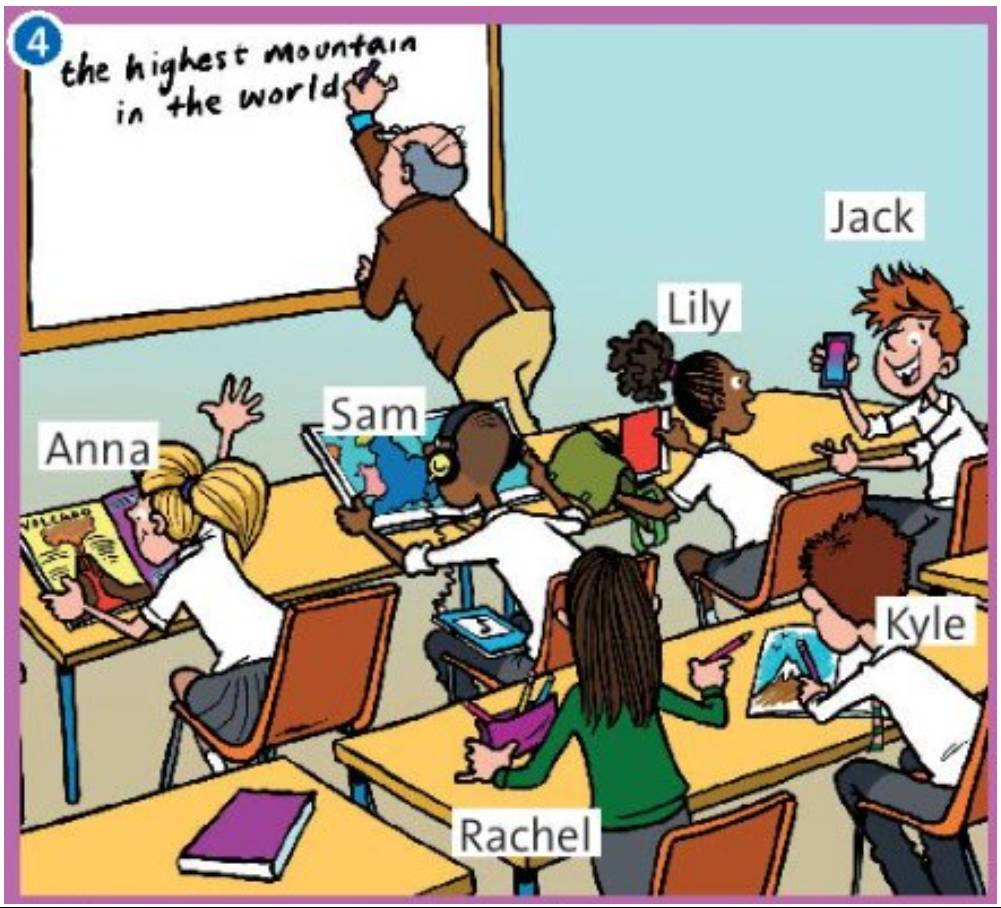
The teacher is writing on the board. (Thầy giáo đang viết lên bảng.)
Lily and Jack aren’t watching TV. (Lily và Jack không xem tivi.)
- Anna is reading a book. (Anna đang đọc sách.)
- Sam is wearing headphones. (Sam đang đeo tai nghe.)
- Lily is talking to Jack. (Lily đang trò chuyện với Jack.)
- Jack is holding a mobile phone. (Jack đang cầm điện thoại di động.)
- Rachel is giving Kyle a pen. (Rachel đang đưa cho Rachel cây bút.)
- Kyle is pointing at a picture. (Kyle đang chỉ vào bức tranh.)
- The teacher isn’t look at the students. (Thầy giáo không nhìn học sinh.)
- Anna and Sam aren’t drawing. (Anna và Sam không đang vẽ.)
- Rachel and Kyle aren’t listening to music. (Rachel và Kyle không đang nghe nhạc.)
Work in pairs. Look at the pictures and use the cues to talk about what people in some places do to maintain their traditional lifestyle.
1. Chau An Village:
- preforming traditional dances
- holding festivals
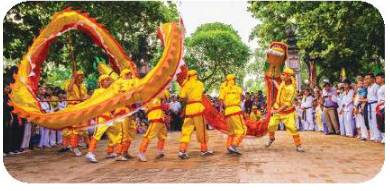
2. Dam Ri Village:
- cooking and selling traditional food
- making crafts
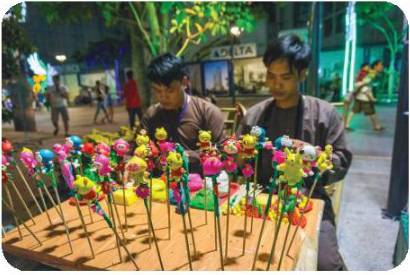
3. Son Ca Village:
- weaving clothing
- singing folk songs
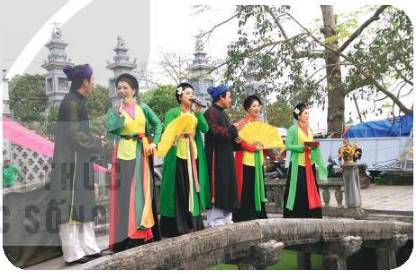
A: What do people in Chau An Village do to maintain their traditional lifestyle?
B: They perform traditional dances. They also ....
Tham khảo:
1. Chau An Village
A: What do people in Chau An Village do to maintain theis traditional lifestyle?
(Người làng Châu An làm gì để gìn giữ lối sống truyền thống của họ?)
B: They perform traditional dances. They also hold festivals.
(Họ biểu diễn những vũ điệu truyền thống. Họ cũng tổ chức các lễ hội.)
2. Dam Ri Village
A: What do people in Dam Ri Village do to maintain their traditional lifestyle?
(Người làng Đạm Ri làm gì để gìn giữ lối sống truyền thống của họ?)
B: They cook and sell traditional food. They also make crafts.
(Họ nấu và bán những món ăn truyền thống. Họ cũng làm đồ thủ công.)
3. Son Ca Village
A: What do people in Son Ca Village do to maintain their traditional lifestyle?
(Người làng Sơn Ca làm gì để gìn giữ lối sống truyền thống của họ?)
B: They weave clothing. They also sing folk songs.
(Họ dệt vải. Họ cũng hát dân ca nữa.)
Work in pairs. Look at the picture and answer the questions.

1. What can you see in the picture?
2. When do we need these things?
1. I can see an emergency kit.
2. We need these things when it has a natural disaster.